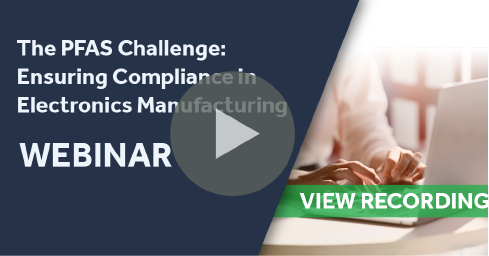INFORMATION HUB
Understanding PFAS Compliance
Per- and polyluoroalkyl substances (PFAS) are a large, complex group of synthetic chemicals that have been linked to a number of health problems, including cancer, liver damage, and developmental problems in children. Many regulatory bodies around the globe are racing to implement PFAS compliance requirements.


OVERVIEW
What are PFAS Chemicals?
PFAS is not a specific chemical or mixture, but rather a group of man-made fluorocarbon compounds. PFAS are referred to as “Forever Chemicals” because they break down very slowly and accumulate in the environment and in human tissue, including the liver.
Currently, there is no master list of PFAS Chemicals, but the Organisation for Economic Co-operation and Development (OECD) has identified and listed over 4,700 PFAS chemicals, and the U.S. Environmental Protection Agency (EPA) has identified and listed over 12,000.
Read on to learn the various strategies that regulatory bodies are using to regulate this vast class of chemicals.
Global Approaches to PFAS Restrictions
View this clip from our Webinar "The PFAS Challenge" to learn how regulatory bodies around the globe are restricting PFAS "forever chemicals" and implementing PFAS regulations.
PFAS Regulations by State
MAINE
Maine PFAS Law
Effective January 1, 2032, any products that contain intentionally added PFAS may not be sold, offered for sale, or distributed for sale in Maine, unless the DEP determines by rule that the use of PFAS in the product is a currently unavoidable use.
Manufacturers may individually or collectively submit proposals for currently unavoidable use (“CUU”) determinations to PFASProducts@maine.gov. A separate proposal must be submitted for each individual combination of product category and the associated industrial sector. Details on the contents of what should be included in each proposal can be found under section 9.A of the proposed text.
MINNESOTA
New PFAS Regulation in Minnesota Coming in 2026
Effective January 1, 2025, the sale or offer for sale of various products containing intentionally added PFAS will be prohibited in Minnesota. House File 2310 (HF 2310) establishes stringent reporting requirements for manufacturers and introduces a certificate of compliance process to ensure adherence to the regulations. Manufacturers of products containing PFAS must submit detailed reports to the state, providing comprehensive information on the chemical composition, production volume, and intended uses of their products.
VIDEO
New PFAS Restrictions in Minnesota
Learn about the new regulation restricting PFAS in products in Minnesota.
NEW MEXICO
New Mexico's New PFAS Regulation
Under the “Per- and Poly-Fluoroalkyl Substances Protection Act” (HB 212), effective January 1, 2032, no manufacturer may sell, offer for sale or distribute for sale, directly or indirectly or through intermediaries, any product that contains intentionally added PFAS in the state of New Mexico, unless the EIB has adopted a rule providing a Currently Unavoidable Use (CUU) for that product.
Certain product categories are exempt from the regulation, including:
- Semiconductor and the equipment and materials used in the manufacture of semiconductors.
- Non-Consumer electronics and non-consumer laboratory equipment not intended for personal, family or household purposes.
This regulation does directly impact producers of electronic or electrical devices intended for use in consumer applications. Additionally, some products have bans that take effect before the general prohibition in 2032. You can find a list of those products as well as a list of products that are exempt from the regulation here.
California Proposition 65
PFAS Regulations in California
California currently lists three PFAS chemicals on the Proposition 65 substance list:
- Perfluorooctanoic acid (PFOA)
- Perfluorooctanesulfonic acid (PFOS)
- Perfluorononanoic acid (PFNA)
While PFOA and PFOS have largely been phased out of use in the United States, they continue to be manufactured overseas and are used in products or components used in finished goods that are ultimately sold in the United States.
Additionally, three PFAS chemicals are currently under review by the Office of Environmental Hazard Assessment (OEHHA) for possible addition to the Proposition 65 substance list:
- Perfluorodecanoic acid (PFDA)
- Perfluorohexanesulphonic acid (PFHxS)
- Perfluoroundecanoic acid (PFUnDA)
Businesses that expose the California public to these PFAS chemicals, either by exposure from a product or from a business location, may be required to provide warnings to consumers. The specific warning requirements depend on the level of exposure and the type of product.
VIDEO
What are the PFAS restrictions in the US at the state level?
Learn about state-level restrictions on PFAS "Forever Chemicals" in the US, including PFAS regulations in California, Maine, Minnesota, and Colorado.
GreenSoft’s Solution for PFAS Compliance:
GreenSoft takes a proactive approach to PFAS compliance by identifying PFAS in your supply chain so you can meet current requirements and be prepared when new ones arise.
U.S. EPA TSCA Section 8(a)(7)
New TSCA PFAS Rule
The U.S. TSCA Rule 8(a)(7) mandates manufacturers to report and maintain records for specific per- and polyfluoroalkyl substances (PFAS). This rule aims to gather data on PFAS production and usage in the U.S., aiding the Environmental Protection Agency (EPA) in evaluating PFAS risks to human health and the environment.
Manufacturers must report the following information for each year since 2011:
- Company and plant site information.
- Chemical-specific information:
- The common or trade name of the PFAS
- Chemical Identity (CAS # or TSCA Accession Number / LVE number)
- The representative molecular structure of each PFAS.
- (If the specific chemical identity of the PFAS is unknown or not attainable, submitter can provide a generic name or description of the PFAS.)
- The physical form(s) of the PFAS. For articles – “other solid” would be the likely selection.
- Categories of Use & Functional Category
VIDEO
PFAS Restrictions in the US under Toxic Substances Control Act (TSCA) Section 8(a)(7)
Learn about the U.S. TSCA Section 8(a)(7) Reporting and Recordkeeping Requirements for Perfluoroalkyl and Polyfluoroalkyl Substances (PFAS).
CANADA
Canadian Environmental Protection Act (CEPA) 71(1)(b)
On July 24, the Canadian Minister of the Environment enacted new provisions to the Canadian Environmental Protection Act (CEPA) related to PFAS in electronics and other products. CEPA 71(1)(b) required companies to report on their import, production, and usage of 312 specific Per- and Polyfluoroalkyl Substances (PFAS) during the calendar year of 2023.
The reporting period has ended as of Jan 29, 2025, and no new additional surveys will be accepted. However, companies that had submitted an extension prior to the deadline date, may still submit their reports. At present, there are no plans for reporting beyond 2023. The data collected from the surveys will inform future actions under the Chemicals Management Plan.
The list of the 312 in-scope PFAS can be found here, along with the full text of the regulation provisions. Canada has also released a guidance document which can be found here. The Reporting Template required to be used for submissions can be found here. Submissions should be made using Canada’s online reporting tool here. Requests for extensions from the reporting requirements or concerns about proprietary information may be addressed directly to substances@ec.gc.ca before the original deadline.
VIDEO
New PFAS Restrictions in Canada
Learn about the requirements and scope of the Canadian Environmental Protection Act (CEPA) Section 71(1)(b) on PFAS. This is a preview clip. Watch the full 30 minute video here.
EUROPEAN UNION
PFAS Regulations in Europe
EU POP
The European Union (EU) updated its Persistent Organic Pollutants (POP) regulation on August 8, 2023, to restrict the production, use, and release of perfluorohexane sulfonic acid (PFHxS), its salts, and PFHxS-related compounds. This move aims to minimize PFHxS's environmental impact due to its persistence and potential health risks. The restrictions include manufacturing bans, stockpile management requirements, and emission control measures.
EU REACH SVHC
There are currently 6 PFAS chemicals on the EU REACH Substances of Very High Concern (SVHC) list:
- Perfluorooctanoic acid (PFOA)
- Perfluorooctanesulfonic acid (PFOS)
- Perfluorononanoic acid (PFNA)
- Perfluorohexane sulfonic acid (PFHxS)
- Dodecafluoroheptanoic acid (DHFoA)
- Nonadecafluorododecanoic acid (NDFA)
Under EU REACH, manufacturers are required to submit detailed reports including information on the chemical composition, production volume, and intended uses of PFAS-containing products to the European Chemicals Agency (ECHA). Manufacturers must also provide data on the release of PFAS into the environment throughout their supply chains.
VIDEO
Discover the Existing and Proposed PFAS Regulations in the European Union
Learn about the status of PFAS regulations in the EU and how your products could be affected.
Data Sheet
GreenSoft's PFAS Solution
A PROACTIVE APPROACH TO PFAS COMPLIANCE
FAQ
PFAS Frequently Asked Questions
Browse our frequently asked questions about PFAS compliance and learn about the different regulations restricting the use of PFAS.
Is there a universal PFAS list of chemicals?
Currently, there is no master list of PFAS Chemicals, but OECD has identified and listed over 4,700 PFAS chemicals, and the EPA has identified and listed over 12,000.
Where are PFAS commonly found?
Consumer products: Common household products that contain PFAS include non-stick cookware, water-resistant materials like rain jackets, umbrellas, and tents, and personal care products.
Electronic products: In the electronics industry, PFAS are found in PCB Laminates, wires and cables, passive components, displays, batteries, and packaging.
Environment: PFAS chemicals accumulate in drinking water, in the soil, air and ocean, and in the tissue of humans and animals.
Who has to follow PFAS guidelines?
Manufacturers and Importers: In the United States, all manufacturers (including importers) of PFAS and PFAS-containing articles are now required to report information to the EPA under TSCA Section 8(a)(7). In the European Union, manufacturers are subject to PFAS restrictions under the EU POP and EU REACH regulations.
Industries using PFAS: Specific industries that rely on PFAS, like firefighting or certain manufacturing sectors, may have to adhere to regulations regarding how they handle and dispose of PFAS-containing materials. These regulations will vary depending on the industry and the specific application.
Which states have PFAS regulations?
Nearly half of the states have established or proposed health guidelines and notification levels or MCLs for PFAS in drinking water, and several states have enacted legislation regulating PFAS in firefighting foam and equipment. However, when it comes to manufacturers of electronic products, the only states that currently have specific PFAS reporting requirements are Maine, Minnesota, and California.
Why are states so varied in PFAS restriction levels and scope?
As scientific understanding and public awareness continues to evolve, the PFAS regulatory landscape remains dynamic. Varying assessments of health risks, differing regulatory powers, economic concerns, public pressure, and political leanings all contribute to the lack of coordination between states on PFAS regulations.
Additionally, these proposals are typically drafted and proposed by individual legislators acting on behalf of their constituents and lobbying groups, not scientists or subject matter experts.
What are the PFAS regulations for 2024?
The current PFAS regulations in place affecting electronics producers are Maine's PFAS Law, Minnesota’s PFAS Law, U.S. TSCA Section 8(a)(7), certain PFAS chemicals restricted under California Proposition 65, PFHxS substances restricted under the EU POP regulation, and certain PFAS chemicals listed on the EU REACH Substances of Very High Concern (SVHC) list.
Potential new PFAS regulations in 2024 include three additional PFAS chemicals restricted under California Proposition 65, a proposed restriction to ban the use of PFAS in firefighting foams in the EU, and a proposed broad ban on all PFAS usage in the EU.
In what type of products will the PFAS regulation in the EU apply?
Manufacturers of any product that is subject to the EU POP and EU REACH regulations must adhere to the PFAS requirements of those regulations. Additional PFAS restrictions, currently under evaluation, aim to tackle PFAS across a wide range of products including firefighting foams, textiles, and food contact materials.
Specifically for electrical and electronic equipment, PFAS in wires, cables, and certain electronic components will be restricted, aiming to reduce their release during recycling and waste disposal.
How does GreenData Manager cover the requirements for PFAS?
GreenData Manager's custom PFAS rule allows you to scan your products against the OECD’s list of 4,700 PFAS chemicals and the EPA’s list of 12,000 PFAS chemicals, or your own custom list of PFAS chemicals. Uncover hidden PFAS in your products with ease and ensure compliance in this ever-changing regulatory landscape.
Still have PFAS questions?
PFAS Resources
Articles
Videos
Video
GreenSoft's PFAS Solution for Electronics Manufacturers
Get help with your PFAS requirements for regulations in the US and EU. GreenSoft offers a comprehensive solution for electronics manufacturers.
Video
New PFAS Restrictions in Canada
Learn about the requirements and scope of the Canadian Environmental Protection Act (CEPA) Section 71(1)(b) on PFAS. This is a preview clip. Watch the full 30 minute video here.
Webinar
The PFAS Challenge: Ensuring Compliance in Electronics Manufacturing
GreenSoft industry expert Randy Flinders and covers the current status of global PFAS regulatory requirements.
Video
What are PFAS Chemicals?
Discover what PFAS "forever chemicals" are, the different definitions of PFAS under various regulations, and how many PFAS are identified by EPA and OECD.
Video
PFAS Frequently Asked Questions
GreenSoft Compliance Expert Randy Flinders answers Frequently Asked Questions on PFAS "Forever Chemicals" and various PFAS regulations around the globe.
Video
New PFAS Restrictions in Minnesota
Learn about the new regulation restricting PFAS in products in Minnesota.
Video
PFAS Restrictions in the US under the Toxic Substances Control Act (TSCA) Section 8(a)(7)
Learn about the U.S. TSCA Section 8(a)(7) Reporting and Recordkeeping Requirements for Perfluoroalkyl and Polyfluoroalkyl Substances (PFAS).
Video
Global Approaches to PFAS Restrictions
Learn how regulatory bodies around the globe are restricting PFAS "forever chemicals" and implementing PFAS regulations.
Video
Overview of PFAS Regulations Affecting Electronics Manufacturers
Get an overview of what PFAS regulations are facing electronics manufacturers in the US and EU.
Video
Discover the Existing and Proposed PFAS Regulations in the European Union
Learn about the status of PFAS regulations in the EU and how your products could be affected.
Video
What are the PFAS restrictions in the US at the state level?
Learn about state-level restrictions on PFAS "Forever Chemicals" in the US. Including PFAS regulations in California, Maine, Minnesota, and Colorado.






